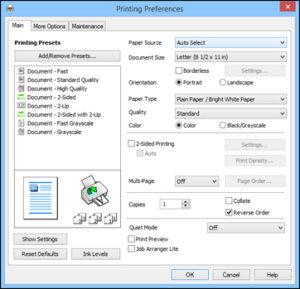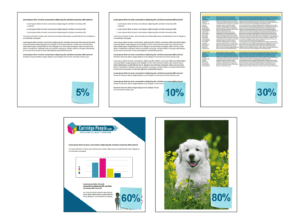
The ink consumption is a factor that can provide a user key insights to help save costs even if it appears as an estimate. Knowing the approximate ink consumption can help one estimate costs, measure and quantify waste generation costs, and get an overall handle on the latent expenses that may creep in over a long period of time and may go unnoticed otherwise. If you are concerned about – “How to calculate ink consumption?”, then you must read this article.
Ink consumption – The misconception
When it comes to ink consumption there is a common misconception that compatible or third-party inks imply more consumption than the original inks for the same color vibrancy.
Well, this is Absolutely NOT TRUE. As long as your compatible ink manufacturer is making printer-specific inks, the ink consumption of such compatible inks is very close to that of their original counterparts.
This is because printer-specific inks maintain their physical and chemical properties to be very similar, almost identical.
In the case of textile printers, the RIP software provides a way to measure the ink consumption levels. However, there is no such way available for desktop and large-format printers.
So we have come up with a way to approximate the ink consumption in a manner as simple as possible to implement. Before we get into that, it is necessary to understand what factors actually affect the consumption of ink.
Let us have a look at the most significant ones.
Factor affecting ink consumption
The ink consumption is like a multivariate equation consisting of several components. Let us look at some of the key components or factors that influence ink consumption.
These factors are independent of the type of ink being used which by and large means that irrespective of whether you use dye inks, pigment inks, or sublimation inks, the role of these factors in affecting the ink consumption will be the same.
Print Media

The type of substrates you print on, i.e. the papers you use for printing, also known as the print media, is one of the key factors that can affect ink consumption.
A simple example of this can be illustrated by comparing two popular types of media: coated and uncoated.
In simple terms, coated media has a coating over it that helps hold the ink on its surface. This coating is absent in the case of the uncoated media.
It is obvious that the uncoated media will consume relatively larger amounts of ink than coated media to achieve the same color vibrancy because the coating in the coated media will facilitate the retention of colors on the surface of the media which will eventually make the colors more vibrant than its uncoated counterpart which inherently does not have the coating and will absorb a significant amount of ink before the colors actually start showing on the surface.
Print Settings

Though it does seem pretty obvious, the settings that are configured for the printing affect the ink consumption on a considerable scale.
To illustrate this, consider a simple example – Imagine that you are printing on photo paper and you set the print settings to that of the matte paper.
Now since the photo papers generally have a glossy finish contrary to the matte-finish papers, this mistake in settings is going to cause you to use more ink to get close to the quality and sharpness that could easily be achieved with the right settings.
Even so, in almost all printers, there are different inks for photo and matte media. So evidently, you would end up consuming an amount of the wrong ink and not even get the quality you were looking for.
With this into consideration, it is safe to remark that the right print settings are a prerequisite for the first step in achieving optimum ink consumption.
Print Coverage
The print coverage represents how much area of the paper is the print going to cover. It goes without saying that the higher the print coverage, the higher will be the consumption of ink.
However, this conclusion is drawn based on the assumption that the print is a solid fill with minimum or no white spaces on it.
So it does not necessarily mean that a less intricate design printed across a larger area of paper will consume more ink than a highly complex intricate design printed across a smaller one.
However, in all cases, the print coverage trumps the design intricacies because the discrepancy in ink consumption caused by it is significantly larger. In simple words, for the same design, if you are printing over a larger area, you will obviously consume more ink.
Number of cleaning cycles
It is not necessarily an additive factor in ink consumption but is a factor nonetheless. A cleaning cycle uses a certain amount of ink whenever it is executed.
This ink is not utilized for printing but is consumed nevertheless. So the number of cleaning cycles also influences the ink consumption.
How can you calculate your ink consumption?
Through years of experience and rigorous collection of data, we have been able to reach an empirical relation between the quantity of ink and print coverage.
This relation will give you an approximation of how much ink you have consumed based on your print coverage.
The relation is – 1 ml of ink is consumed to print 1 square feet of solid fill area with 100% page coverage.
A corollary of the above relation can also be extended towards the considerations of page coverage. For example, if you are printing 10 sheets of 1 square foot each with 10% page coverage, you will consume 1 ml of ink.
Similarly, printing 5 sheets of 1 square feet each with a 20% page coverage will consume 1 ml ink and so will 2 sheets of 1 square feet each with a 50% page coverage.
Features of the relation:
- Since this relation takes into account a solid fill at 100% page coverage, it has already assumed the maximum ink consumption possible.
- So the approximation of ink consumption is a little on the higher side, which is quite safer than being on the lower side, which may lead to huge miscalculations in the long run.
- This relation works for all desktop and large-format printers
- This relation is independent of the type of ink.
Now, to calculate your ink consumption, all you have to do is calculate your overall page coverage in square feet and apply the above relation.
Disclaimer: – The relation mentioned here gives an approximate ink consumption and not an actual value.




